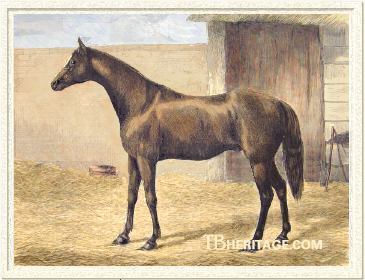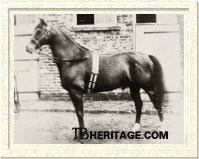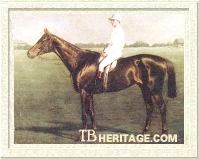|
|
Cambuscan

|
|
 |
|
|
Cambuscan, a handsome chestnut son of Newminster, was an above-average stayer. Not a big success at stud in England, where he left CAMBALLO, a Two Thousand Guineas winner that later got two classic winners, he was sold to the Hungarian national stud where the amazing race mare KINCSEM emerged from his first crop. Today he is seen in pedigrees through descendants of his daughters and the daughters of his sons.
Cambuscan (1861) was bred at the royal stud at Hampton Court, where his dam, The Arrow, by Slane, was a broodmare. The Arrow's dam, Southdown, had bred the speedy stayer Alarm (by Venison). In addition to Cambuscan, The Arrow bred His Lordship (1870, by Lord Clifden), a decent steeplechaser that won a number of races, including the Derby Hunt's Shipley Hall Steeplechase and the Hereford Open Hunt Steeplechase, both over three miles, carrying heavy weight. Cambuscan was purchased by George Harry Grey (7th Earl of Stamford, 3rd Earl of Warrington) at the annual Hampton Court yearling sale. Stamford was a gentleman sportsman, master of the Quorn Hunt between 1856 and 1863, and a gambler who took big plunges. He did not have a lot of success with his racehorses, but his colt Diophantus won the Two Thousand Guineas in 1861, the year Cambuscan was born. At the end of his life he owned the beautiful, weight-carrying filly Geheimness, winner of twenty of her thirty-one starts, including the Epsom Oaks and Ascot's Trial Stakes.
Cambuscan was "full of style," a handsome liver chestnut somewhat on the leg, lacking the lengthy look of the ususal Newminster youngster. He ran in top company, winning nine races in his four seasons on the turf, including Newmarket's July Stakes as a juvenile and the Newmarket Biennial at age four. In Blair Athol's Derby he was fourth, and was third that year in the Doncaster St. Leger. Like other Newminster sons, he could stay, and at age four he won the Biennial at Newmarket Craven and was second to Ely in Bath's Beaufort Cup and both the 2-1/2 mile Brighton Gold Cup (receiving seven pounds from Ely and beaten by two lengths), and the Goodwood Cup (receiving ten pounds from Ely and beaten by six lengths, with Caller Ou third). He was the sales-topper at Stamford's dispersal sale in 1864, but was soon repurchased, and retired from the turf in Stamford's ownership.
Cambuscan in the Stud
Cambuscan stood at stud in England until 1872; after the breeding season that year he was purchased by Mr. Cavaliere for the Hungarian national stud at Kisber. He was a barely useful sire in England, placing sixteenth on the sire's list in 1871, seventh in 1874 and tenth in 1875 when his son CAMBALLO, in his last English crop, was winning, and he also got a number of low-level winning steeplechasers and good hunters. In Austria-Hungary he did much better as a stallion, and was the sire of many successful runners, most notably the famous, unbeaten toast of Europe, KINCSEM. Cambuscan's only classic winner, the English-bred CAMBALLO, was among the top twenty sires in England six times, and placed fifth in 1884 and sixth in 1887 when he had youngsters that won classic races -- The Lambkin (Doncaster St. Leger) and Minthe (One Thousand Guineas). Cambuscan's principal legacy was through his daughters, including KINCSEM, IDALIA, and FAIR ALICE, whose offspring were good winners and influential breeding stock in Germany, Austria-Hungary, France, New Zealand, the United States and South America.
In the British Isles Cambuscan got BOTHERATION (1868, from Troublesome by Hobbie Noble), winner of Goodwood's 1-1/2 mile Chesterfield Cup; CAMBUSLANG (1870, Hepatica by Voltigeur, bred at Hampton Court stud), winner of the 1-1/2 mile Manchester Cup; FAIR ALICE (1873, Young Alice by Young Melbourne), a winner of the four mile Royal Whip at the Curragh at age three; and the golden red CAMBALLO. Some of Cambuscan's winning steeplechasers included CAVALIERO, BUSKIN, and MISS WINGIE.
|

Camballo
| |
CAMBALLO (1873, Little Lady by Orlando) was bred by Lord Stamford and purchased as a yearling by Robert "Clare" Vyner, who sent him to the good Yorkshire trainer Mat Dawson. He was ridden by John Osborne in most of his races, who said of him, he was "not a quick beginner, but when in action he was a fine mover, and could stay." Camballo was a good juvenile that took Doncaster's Champagne Stakes, Ascot's Biennial Stakes, Stockbridge's Hurstbourne Stakes, and Newmarket's July Stakes. At age three he won the Two Thousand Guineas, but his win was disputed; Osborne, who had the ride, said, "Camballo made most part of the running, and won easily; it was never in doubt." He started coughing before the Epsom Derby, but ran anyway, unplaced. He was retired after running second in the Ascot Biennial (second year), while still not right, and went to Vyner's Fairfield Stud in York.
|
CAMBALLO was a disappointing stallion for Vyner, but he did get The Lambkin (1881), winner of the Doncaster St. Leger ("probably the only sound horse in the race'), and his sister Minthe (1886), who won the One Thousand Guineas, both out of Vyner's mare good broodmare Mint Sauce (also dam of Ormonde's generational rival, Minting, by Lord Lyon) by Young Melbourne. The Lambkin could only run second by a neck a few days after the St. Leger in the Doncaster Cup. The Lambkin later got some daughters that bred on, and Ova, a winner of the Grande Premio di Milano.
CAMBALLO'S other good runners, mostly stayers, included Doncaster Cup winner Claymore (also won the Prince of Wales's Stakes and Manchester Cup); Yorkshire Oaks winner Clochette; the two mile Ascot Stakes winner Eurasian; Goodwood Stakes winner Ralph Neveille; Irish Royal Whip (4 miles) winner Campanula, Irish Cesarewitch winner Hospodar; Great Yorkshire Stakes winner Peppermint, and Nunthorpe (1886, from Matilda by Beauclerc), whose wins included Epsom's City and Suburban handicap, Kempton Park's Jubilee Handicap, and the Liverpool Summer Cup.
Nunthorpe's daughter Nunsuch (1894), a winner of Newcastle's Great Northern Derby and other races, became second dam of the unbeaten juvenile runner and sprinter Friar Marcus, later a leading broodmare sire in England. Another Nunthorpe daughter, Emotion, a good juvenile, was, through daughter Bellavista, second dam of Derby winner Captain Cuttle, later a leading sire in Italy.
Peppermint also won the Great Northern Leger at Stockton and the Londesborough Cup at York for his owner-breeder, the trainer-jockey John Osborne, and after winning premiums as a hunter sire at York and at the big London show, he served as a successful sire of hunters and jumpers.
CAMBALLO was dam's sire of the 1898 Epsom Oaks winner Airs and Graces (by Ayrshire, later dam of the good French runner Jardy), of Wild Lad, a winner of the Liverpool Autumn Cup, and of the good Irish-bred sprinter Whiston (by Priam).
Cambuscan's son, CAMBUSLANG, at stud in Ireland, got the Irish-bred Grand National Steeplechase winner Come Away -- also twice winner of the Conyngham Cup, the famous four mile Irish steeplechase, and five other chases; Conyngham Cup winner Belmont, and Irish Cesarewitch winner Baron Farney (1877, from XL). He also got Asta, who was sold to France, where she produced Alice (1887 by Wellingtonia), a winner of the Great Ebor Handicap, and her half-brother Arreau (1893, by Clover), winner of the Poule d'Essai des Poulains and the Grand Prix de Paris.
Cambuscan's daughter, FAIR ALICE, a half-sister to the good Irish sire Ben Battle, became the dam of Orbit (1885, by Bend Or), winner of Newmarket's Craven Stakes and Sandown's Eclipse Stakes among other races and later sire of Old Man (1901), a champion runner in Argentina and later three times leading sire and nine times leading broodmare sire in that country. Fair Alice also producd Photinia (1881, by Uncas), dam of some good winners.
Cambuscan also got ONSLOW (1869, from Cesarewitch winner Dulcibella by Voltigeur), a fast but unsound runner that won six of his seven races as a juvenile, and his sister, IDALIA (1870). IDALIA, after dropping the in-bred Woodcote Stakes winner Cyprus (1875, by Lord Clifden), was exported to New Zealand, where she produced a series of high class runners to the cover of Traducer, including Canterbury Cup winner Betrayer (1876, later sire of the terrific steeplechaser The Liberator), New Zealand Derby winner Cheviot (1879, later sire in California of Rey El Santa Anita) and the weight-carrier and stayer Sir Modred that, from California, became the leading sire in the U.S. in 1894. Ogden (1894 by Kilwarlin-Oriole; sire of The Finn, Sir Martin, Lady Doreen) was another good runner and sire in the U.S. that descended from Cambuscan via his French-bred daughter, FENELLA (1869, from La Favorite by Monarque).
Cambuscan's daughter STORM (1873, from Lightning by Thunderbolt) became the tail-female ancestress of many good stakes winners all over the world; a recent descendant was Sumayr (1982), winner of the Grand Prix de Paris and other good races. Another daughter, REVEILLON (1873, from Media Noce), also bred on, with numerous stakes winners in tail-female, including Prix du Jockey Club winner Thor (1930), the grand stayer High Line (1966), and more recently the good staying gelding Valuable Witness (1980).
|

Kincsem
| |
From Cambuscan's first Kisber crop came the unbeaten superior staying mare KINCSEM (1874, Water Nymph by Cotswold), later a successful broodmare. She was bred by Ernest de Blascovich, who had bought the Hungarian One Thousand Guineas winner Water Nymph and sent her to Cambuscan at the national stud. Kincsem won all ten of her juvenile races, in Germany, Hungary and Austria, all seventeen races in those countries and Czechoslovakia -- including classic and semi-classic races -- at age three, all her four year-old-races, including the Grand Prix de Deauville, the Goodwood Cup, and the Grosser Pris von Baden, and all her races at age five, including a repeat win of the Grosser Pris von Baden. She won fifty-four races in five countries, in total, and was never defeated. She bred five foals, two classic winners in Germany and Austria, a stallion son, Talpra Magyar, that got classic winners in Austria-Hungary, and a daughter that bred on. Her tail-female line has persisted into the present era.
|
Other Cambuscan winners bred in Hungary included ALTONA (1975, Sophia Lawrence by Stockwell), winner of the Magyar Kanca dig Budapest (2400 meters) and the Preis der Diana in Germany; ILLONA (1876, from Theresa by King Tom), winner of the same two races and the Nemzeti dij Budapest, and her brother, ISOLANI (1877), also a winner of the Nemzeti dij Budapest and of the Magyar St. Leger (2800 meters); Deutsches Derby winner GAMIANI (1877, Grand Duchess by Stockwell); MERENY (1877, Mildred by Rataplan), another winner of the Preis der Diana and the Magyar Kanca dig; two more winners of the Magyar Kanca dig, GYONGYVIRAG (1879, Harmat by Ostreger) and CAMBRIAN (1880, Panique by Buccaneer); two more winners of the Magyar St. Leger, FRANGEPAN (1880, Fregatte by Buccaneer) and PASZLOR (1881, Lady Patroness by Buccaneer); and CAMBUS (1881, Gaiety by St. Tom), a winner of the 2400 meter Furstenberg Rennen at Baden-Baden.
As a broodmare sire in Hungary, Cambuscan was responsible for Deutsches Derby winner Budagyongye and his sister Ollyan-Ninca, a winner of the Magyar St. Leger and other races, both out of Kincsem; for Prix du Jockey Club winner Dandin; for Austrial Trial Stakes winner Inaska, and other good runners in Austria-Hungary and Germany.
--Patricia Erigero
|
|
|
|

